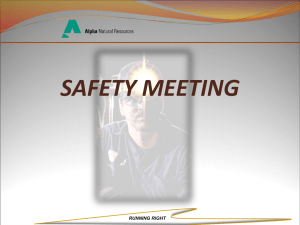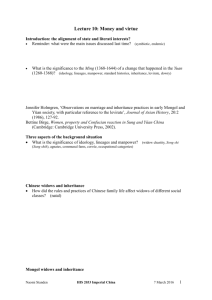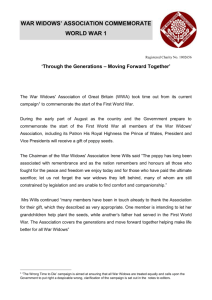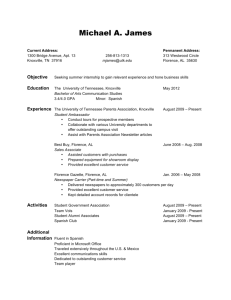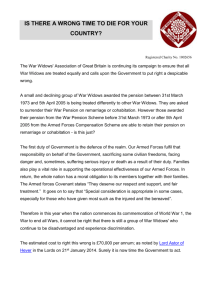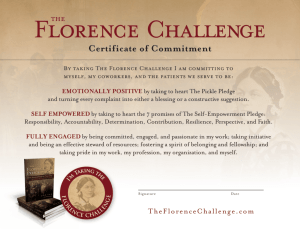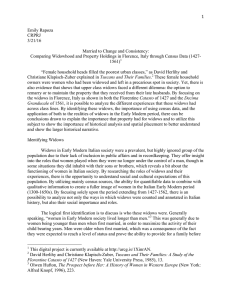FLORENTINE WIDOWS AND PROPERTY: A SPATIAL ANALYSIS A CREATIVE PROJECT
advertisement
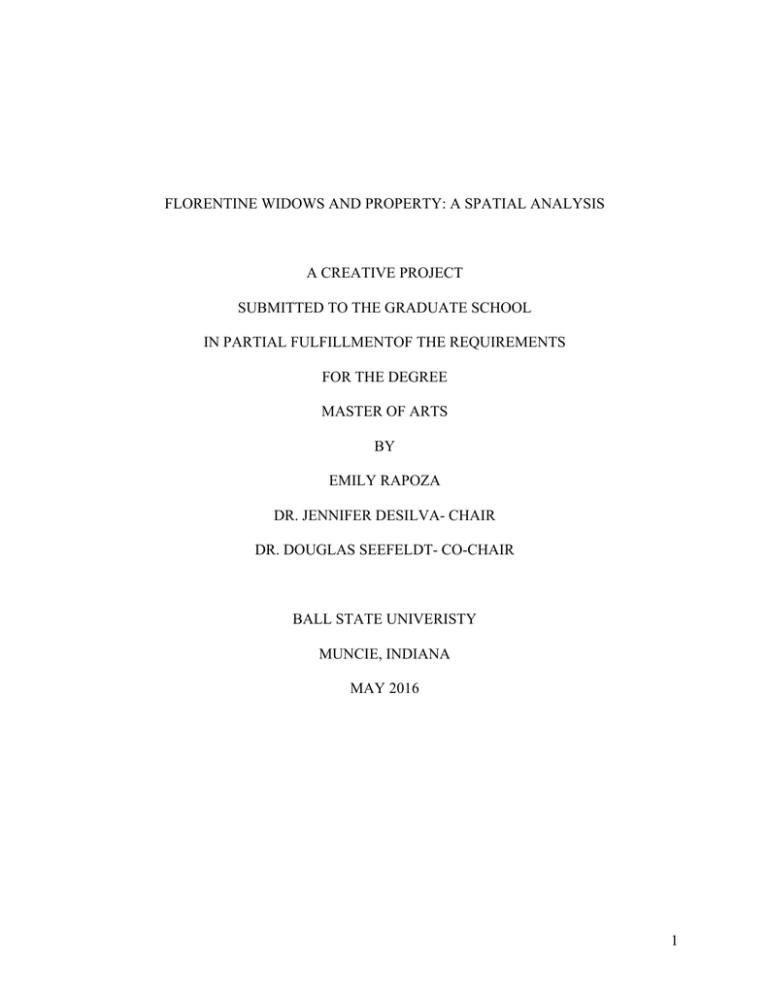
FLORENTINE WIDOWS AND PROPERTY: A SPATIAL ANALYSIS A CREATIVE PROJECT SUBMITTED TO THE GRADUATE SCHOOL IN PARTIAL FULFILLMENTOF THE REQUIREMENTS FOR THE DEGREE MASTER OF ARTS BY EMILY RAPOZA DR. JENNIFER DESILVA- CHAIR DR. DOUGLAS SEEFELDT- CO-CHAIR BALL STATE UNIVERISTY MUNCIE, INDIANA MAY 2016 1 Process Paper CREATIVE PROJECT: Florentine Widows and Property: A Spatial Analysis STUDENT: Emily Rapoza DEGREE: Master of Arts COLLEGE: Sciences and Humanities DATE: May 2016 This project is currently available at http://arcg.is/1XinrAN. The creation of “Florentine Widows and Property: A Spatial Analysis” has been the culmination of multiple learning experiences throughout this degree. The interest in widowhood and Early Modern Florence originated in classes with Dr. Jennifer DeSilva that examined the culture of Renaissance Europe, with a large focus upon Italy. After researching marriage and women’s roles within society as wives, my attention was turned to widows and the unique role that they fulfilled in society. These women acted like men in certain circumstances and were able to cross gender and social lines unlike almost all married women of the period. This led to two separate research papers on widows and, more specifically, widowhood and the importance of property. While researching widows in Florence, I took Dr. Douglas Seefeldt’s Digital History Seminar, which focused on the teaching of new Digital Humanities tools and methodologies to show historical data. Using GIS mapping as well as Spatial Humanities methods, including multimedia GIS and animated, interactive maps, I saw an opportunity to explore census records further to help explain the scholarship of Florentine widows. In celebration of GIS Day, Drs. DeSilva and Seefeldt welcomed Colin Rose, a PhD candidate from the University of Toronto, to Ball State and to present his work on the DECIMA 2 Project (The Digitally Encoded Census Information and Mapping Archive). This online project, centered around ArcGIS mapping software, plots entries of the 1561-62 Decima Granducale census that was taken by Duke Cosimo I in Florence. The Decima offered information about each household in Florence, including property owners, inhabitants, occupations, rent, and location. In visualizing what the data offered in the S. Maria Novella quarter, the first area to be mapped and readily available to the public, these locations offered connections of families, communities, and even marital statuses. In talking with Rose, it became clear that the DECIMA project was going to be vital for examining widowhood during this period. Using the Decima census, I hoped to sort out the widows from the general populace, identify their locations across the city, and show that property-owning women would generally live close to their properties. I also hoped that this would become clear with the use of a mapping tool so the visual locations of widows and their properties could be viewed. By mapping out the data, I wanted this project to help prove that widows in Early Modern Florence were located throughout the city and that they tended to have property close to other members of their families. This would strengthen the argument that upper-class widows (those who owned property in their own name) were provided for by their family or their late husband’s family. This connection would show that even though these women were property owners in their own right, they were still expected to be watched over by male relatives, hence the close proximity of widows and other males in the same family. This shows that although women were acting in the public sphere of society, they were still not without the gaze and protection of the patriarchy. In order to show the above hypothesis, the first step in creating this ArcGIS StoryMap was to research the situation of widows and property. By first composing a large research paper 3 on this topic, it became clear that traditional forms of research could only go so far and only present a limited amount of data. The next step was to search for all the widows in the S. Maria Novella quarter and record pertinent information (latitude, longitude, widow associated with the property and property owner) about them in an Excel spreadsheet. The latitude and longitude for each household were vital in recreating a map of Florentine widows (as opposed to the whole population), while the widow associated with the property and her relation to the property (owner, owner and resident, resident without rent, renter) would give more details about her social class. The wealthier the widow, the more likely she was to have multiple properties and be listed as an owner, not a renter. In putting the data into Excel, it was also obvious to note which widows lived in certain neighborhoods and belonged to certain families, due to their location data or due to the commonality of family name. Widows in the Leon Bianco neighborhood (gonfalone), a subunit of the S. Maria Novella quarter, were placed in their own spreadsheet, as were members (male and female) of the elite Davanzati, Strozzi, and Medici families, that were listed in the S. Maria Novella quarter, to highlight the closeness of widows to other members of their families. After the data points were entered, Angie Gibson, the Geographic Information Systems Specialist for Ball State University Libraries, geo-referenced an 1835 map of Florence and added a layer of all the data points from the DECIMA. This map was chosen due to its accessibility and the ease of reading the streets and important buildings in the city. By making the locations of the city clear, it is much easier to see the locations of widows and their associations to other familyrelated properties, as well as churches, convents, and other neighborhoods and their widows. She then geo-referenced a separate map of Florence from 1493, so I could place key points on it to highlight pertinent areas to the city and to this project. These areas help to not only situate the 4 viewer, but also to provide a view of locations that appear throughout the research (Duke Cosimo’s palaces, prominent churches, the Baptistery where all birth records were held, etc.) This introduction helps to familiarize the viewer with Florence before taking in the city as a bird’s eye-view with no highlighted points of interest in the city. With the geo-referencing done and the Excel spreadsheets adding layers on top of the 1835 map, the next step was to import the maps into ArcGIS StoryMap maker. The map was matched with the corresponding layer of information and then content paragraphs that were informed by the original research paper were imported to contextualize the details and findings of the maps. The StoryMap was then made public on ArcGIS to be accessible to other historians and researchers, as well as the public, as an example of historical spatial analysis and its importance to the discipline of history. The main purpose of this research project was to identify where widows lived and their relationships to their families. By looking at the entries of widows in the Decima Granducale, there was a vague sense of what streets widows inhabited, but it was difficult to see their proximity to one another until the GIS mapping was completed. Once the data could be visualized, the analysis of widows and their property became much clearer, as did their connections to other members of their families. The mapping also proved that widows were not regulated to one particular area of the city, but rather were found all over the city, regardless of their social class. The focus on property-owning widows allows for a specific group of women acting in the public sphere in Florence to be analyzed and better understood. 5 SOURCES AND TOOLS BIBLIOGRAPHY Online Sources Online Catasto of 1427, eds. David Herlihy, Christiane Klapisch-Zuber, R. Burr Litchfield and Anthony Molho (Rhode Island: Brown University, 2002) Accessed February 1, 2016. http://cds.library.brown.edu/projects/catasto/newsearch/. “Online Catasto of 1427 Florence, Italy.” European History Primary Sources, 2012. Accessed January 15, 2016. http://primary-sources.eui.eu/website/online-catasto-1427-florenceitaly/. Terpstra, Nicholas and Colin Rose. “Decima: The Digitally Encoded Census Information and Mapping Archive.” Decima Project, University of Toronto. 2014. Accessed January 19, 2016. http://decima.chass.utoronto.ca/. Print Sources Brown, Judith C., and Robert C. Davis. Gender and Society in Renaissance Italy. London: Longman, 1998. Cohn, Samuel Kline. Women in the Streets: Essays on Sex and Power in Renaissance Italy. Baltimore: Johns Hopkins University Press, 1996. Herlihy, David, and Christiane Klapisch-Zuber. Tuscans and Their Families: A Study of the Florentine Catasto of 1427. New Haven, CT: Yale University Press, 1985. Hufton, Olwen H. The Prospect before Her: A History of Women in Western Europe. New York: Alfred Knopf, 1996. Kent, D. V., and F. W. Neighbours and Neighbourhood in Renaissance Florence: The District of the Red Lion in the Fifteenth Century. Locust Valley, NY: J.J. Augustin, 1982. Litchfield, R. Burr. Florence Ducal Capital, 1530-1630. New York: ACLS Humanities E-Book, 2008. Martines, Lauro. The Social World of the Florentine Humanists: 1390 - 1460. Princeton, NJ: Princeton University Press, 1963. Najemy, John M. A History of Florence 1200-1575. Malden, MA: Blackwell, 2006. Schutte, Anne Jacobson, Thomas Kuehn, and Silvana Seidel Menchi. Time, Space, and Women's Lives in Early Modern Europe. Kirksville, MO: Truman State University Press, 2001. 6 Staley, Edgcumbe. The Guilds of Florence. New York: B. Blom, 1967. Strocchia, Sharon T. Nuns and Nunneries in Renaissance Florence. Baltimore, MD: Johns Hopkins University Press, 2009. Terpstra, Nicholas, and Colin Rose. Mapping Space, Sense, and Movement in Florence: Historical GIS and the Early Modern City. New York: Routledge, 2016. Tombaccini, Donatella. Florence and Its Hospitals: A History of Health Care in the Florentine Area. Florence: Firenze University Press, 2008. Wiesner-Hanks, Merry E. Early Modern Europe: 1450-1789. Cambridge: Cambridge University Press, 2009. DATA ANALYSIS TOOLS ArcGIS and ArcGIS StoryMaps 7

